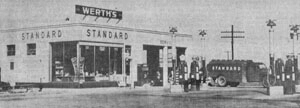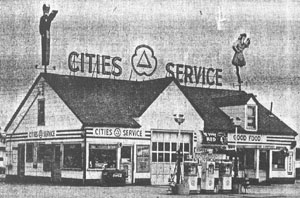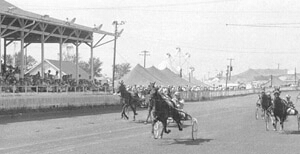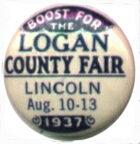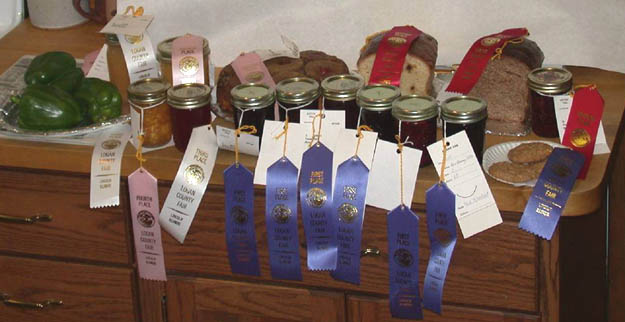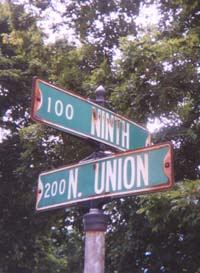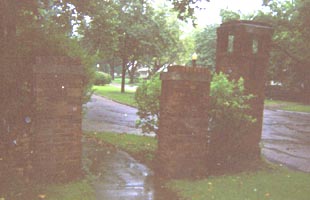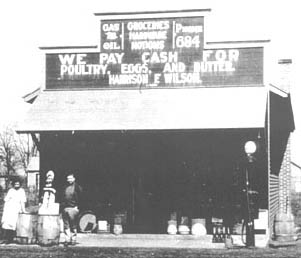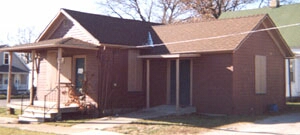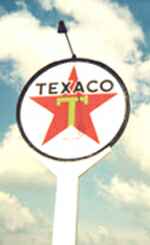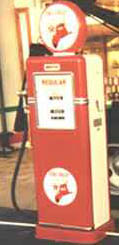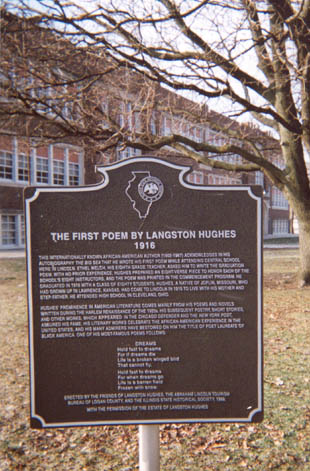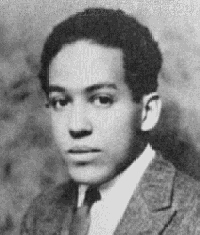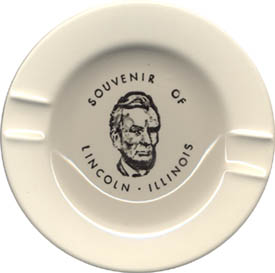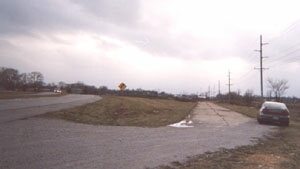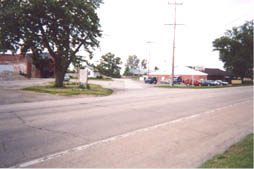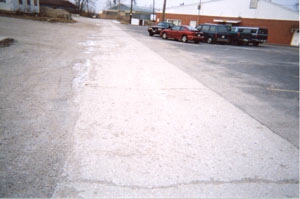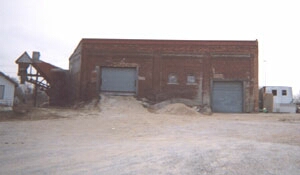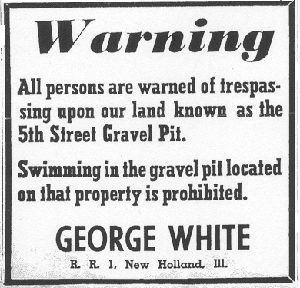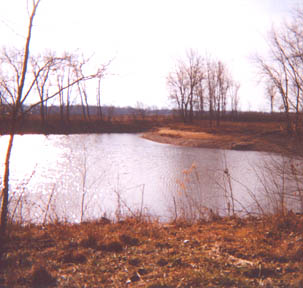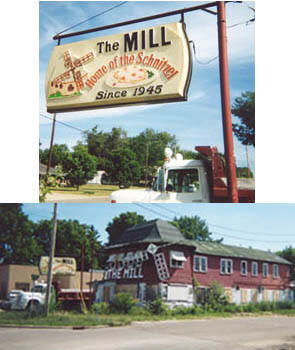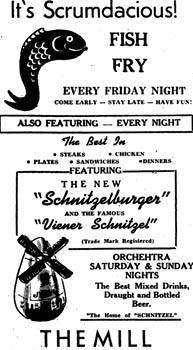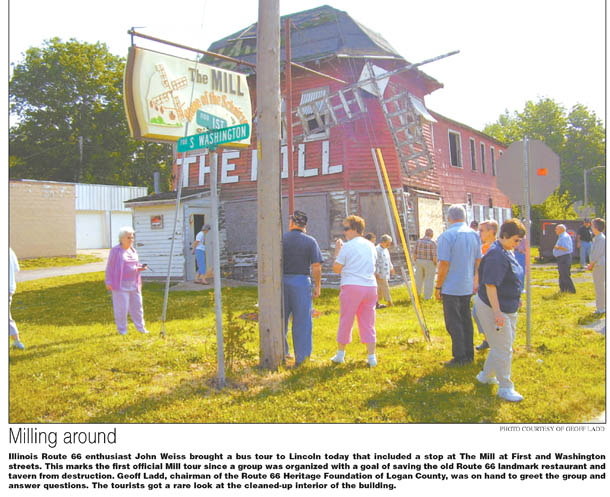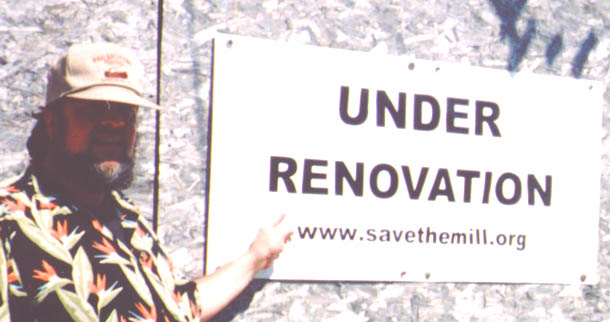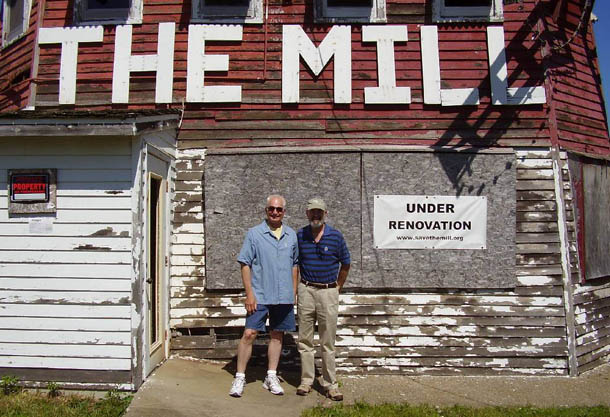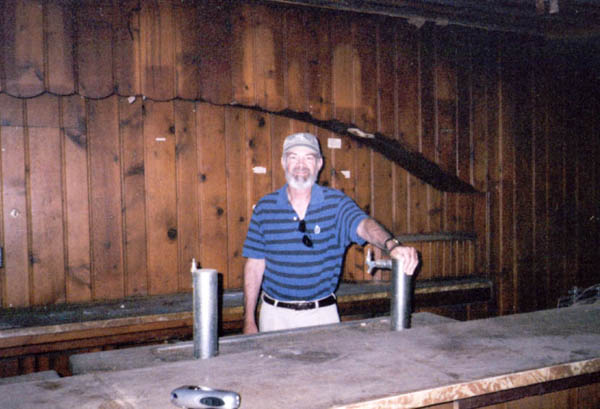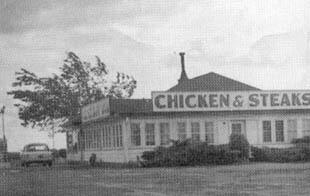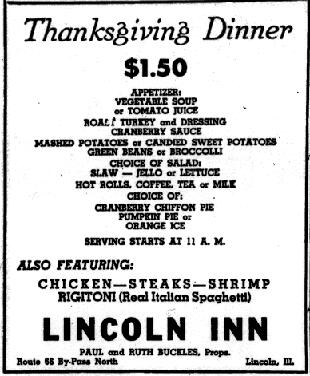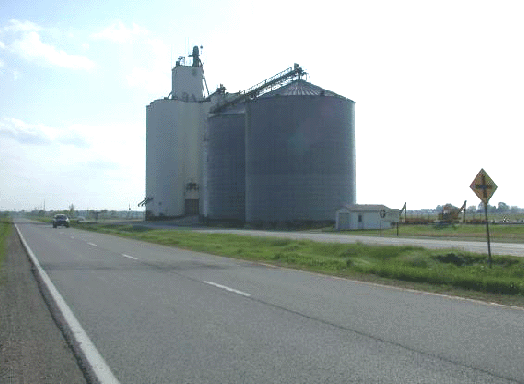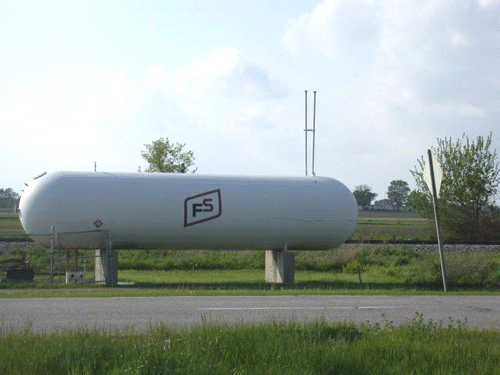
1860 photo taken 4 days after Mr.
Lincoln visited Lincoln, Illinois, for the last time. Info at 3 below.
This President
grew;
His town does too.
Link to Lincoln:
Lincoln & Logan County Development Partnership
Site
Map
Testimonials
Abraham Lincoln Bicentennial Commission of Lincoln, IL
|
Internet Explorer is the only browser that shows this page the way it was designed. Your computer's settings may alter the display.
April 24, 2004: Awarded "Best Web Site of the Year" by the Illinois State Historical
Society
|
|
Marquee Lights of the Lincoln Theater, est. 1923, Lincoln, Illinois |
|
|
|
8. Route 66
Overview Map of Lincoln with "I wonder that so small a place [as Lincoln, Illinois] could hold so much
character." |
|
Maxwell's comment refers to Lincoln in the late 19th and early 20th centuries, but the remarkable nature of Lincoln is evident in every decade. Much of Lincoln's character in the 20th century extending into the present has been formed by the influence of Route 66 and its enduring memory. The billboard depicted below suggests that Route 66 was--and still is--the gateway of opportunity for millions of travelers to visit many marked sites in Lincoln, Illinois (plus numerous unmarked historic sites as identified in this Web site):
8.1: Picture Postcard Image Showing 1960s Billboard on Route 66 at Lincoln, Illinois 8.2: Robert "Bob" Waldmire Picture Postcard of Route 66 at Cemetery Hill Near Salt Creek For photos and descriptions of this location, see 12. Route 66 Map & Photos Showing Salt Creek & Cemetery Hill, Including the Rte. 66 Bridges, GM&O Bridges, Madigan State Park, & the Old Dam in this Web site. For information about Robert Waldmire and where to find and buy Route 66 picture postcards by him, see Sources Suggested below. Many people, from historians to ordinary US citizens to international tourists, consider Route 66 the most important highway in 20th-century America. Popular books about Route 66 usually attempt to cover the entire span of Route 66, geographically and historically, so chapters are typically devoted to all eight states crossed by this route. Thus, even major cities are only briefly represented in these treatments. |
|
|
Only two of
these classic works refer to Lincoln, Illinois, and even those
references have negative implications, neglecting the important history
of the town. In what is arguably the most
popular book about Route 66, Route 66:
The Mother Road, Michael Wallis briefly refers to Lincoln: "Old-timers claim that near Lincoln, Illinois, car
crashes occurred every few hours. On that part of the highway -- as was
the case for similar stretches in Missouri -- the route earned the
nickname 'Bloody 66'" (39). In his classic tour guide, Route 66
Traveler's Guide and Roadside Companion, Author Tom Snyder suggests
Lincoln, Illinois, is a place to ignore: "Lincoln is not a big place, so
it's fairly easy to get through town" (10). Today's Interstates, of course,
have eliminated any special danger of traveling to Lincoln, Illinois.
Route 66 in Lincoln followed two directions: Business 66, the original route, went through residential neighborhoods and ran adjacent to the downtown business district. The "bypass" or "beltline" branch of Route 66 (now part of Business 55), which was completed by the start of World War II, ran along the western and northern perimeters of the city. |
8.3: Bright Highway Signs Beneath Dark Skies Just South of Fifth Street on 1940 Beltline of Route 66 at Lincoln (Leigh Henson photo, 7-02)
Less than a mile ahead on this road on the right is the turn
off to original Routes 4 and 66 brick and concrete pavement. |
| Other cities sometimes changed the streets used to route Business 66 through town, but the route of Business 66 in Lincoln remained unchanged, so re-visiting Business 66 here is straightforward, as shown below on the map at 8.5. | |
|
(Leigh Henson photo, 8-02) This scene occurs on the east side of the Route 66 beltline just about a half mile south of the signs shown in photo 8.2. These truck relics are from Harold Merrill Contractors, Inc. |
|
|
This rest of this page presents my map of Route 66 through and around the city as I recall. You are encouraged to print a copy of this Web page and map to use as a guide during your visit to these historic and interesting locations. Below the map, I briefly identify the 40 sites in the map's legend and offer a few choice corresponding images.
8.5: Diagrammatic Map of Route 66 at Lincoln, Illinois |
|
|
|
|
1. The Tropics. Business 55 & Route 10. Operating, summer 200l. World-famous restaurant opened in 1950 by Vince Schwenoha [shwin-uh-haw][son of John, a.k.a. Coonhound Johnny], who served in Hawaii during tour of duty, so he named his restaurant The Tropics. "The sandwich he had discovered in California -- the bun with two patties of hamburger -- became the Tropicburger" (Nancy Gehlbach, "Let's Eat Out," p. 6). For more information about Coonhound Johnny, see 18. Arts & Entertainment Heritage.
The
Tropics was featured in Route 66 Association of Illinois,
The 66 News, spring, 2001: "The Topics to be Warm Again."
Original restaurant included the South Seas Cocktail Lounge, pictured below at
8.11. |
|
|
8.8: The
Tropics in 1950 |
8.9: The Tropics in 2002 (Leigh Henson photo)
|
|
|
8.11: Route
66-Era |
|
8.12:
The Tropics: South Seas Cocktail Lounge (upper left), |
|
|
2. The Blu-Inn, later the Heritage Inn, then the Court Yard. Business 55 & Rte. 10. Demolished May, 2002.
|
8.14: Cover of Heritage Inn
Menu |
|
8.15: Heritage
Inn, Successor of Blu-Inn |
|
|
Route 66 Motels
8.16: Picture Postcard
of
|
|
|
8.18: Former Ramada Inn on
West Side of Route 66 Beltline 8.19: Former Holiday Inn at Lincoln, Illinois The former Holiday
Inn was located northeast of town on the Route 66 Beltline near the Bennis Auto-Vue.
It thrived in the latter part of the Route 66 era. The upper part of this
postcard shows the lounge with piano just in front of the "fox and hound" mural.
Mid 20th-century Lincoln High alums returning from college often met in the
lounge during vacation times and observed the social activities of Lincolnites from the business and professional communities. |
|
8.20: Former Buckles Motel on North Route 66 Beltline
(Another Spanish design in Lincoln, Illinois) Lincoln Motel on Routes 10 and 121 (17th Street-Woodlawn Road)
8.21: Lincoln Motel Was
Just West of the Dairy Queen |
|
3. Site of the Lincoln Speedway.
Demolished. The Lincoln Speedway is identified above in the description of
the aerial view of the Four Corners in 8.6, where it appears as the
smaller track above the larger Logan County Fairgrounds track. |
|
|
The Lincoln Speedway is one of the subjects described in "Cars. . .and Drivers," Our Times, vol. 3, no.4, Winter, 1998. This article is the basis for the summary of the racetrack presented here. "The speedway was built in 1948 as a racetrack for midget autos." Cost was $60,000, and capacity was 7,000. Hot rod racing began in May of 1949. [Gleason's Lincoln, Illinois: A Pictorial History, p. 144, says the track was constructed in 1947 and seated 5,000.] "By 1957 modified cars were allowed." After owner Howard Langenbahn sold this property in 1965 to Joe Shaheen of Springfield, Illinois, "races became less frequent." Nancy Lawrence Gehlbach writes in her 1998 article that "the racetrack had been vacant for some years when Cricket Levi took a bulldozer to it in 1977" ("The Lincoln Speedway," p. 2).
In this day and age, there is less need for speedway
entertainment as now the average Interstate motorist has become a racetrack
driver -- pushing the accelerator into the radiator, tailgating, California
sliding, and flipping the bird while passing. No wonder many of the
remaining few civilized Americans take to old Route 66 and the blue highways of
a kinder, gentler time. |
8.22: Midget Autos Racing in the 1940s This is not a photo of the Lincoln Speedway, but it does show midget auto in racing in the 1940s and the obvious danger -- no protection: "The little cars had open cockpits and no roll bars, so you 'didn't get but one chance,' says Glen Bradley" (Gehlbach, "The Lincoln Speedway," p. 1). Photo source: |
|
Nancy Gehlbach's article describes the racing life of Mr. Glen Bradley. He says he loved racing, and it helped him to make a living for his family, "although the prize money could be as little as $2.00" (p. 2). "Before Glen was old enough to drive, he had hung around the race track, helping 'Doc' Elkins with his cars. Later he raced Doc's midget racer; he also won many races in Doc's old Hudson. . . ." (p. 2). According to an article in the Lincoln Evening Courier, centennial edition, "the track offers $150 to $500 purses weekly for races there. A number of thrill shows have come to the Lincoln Speedway, but in its history it has had only one major accident ("Lincoln Speedway Thrilling Racing Fans Since 1947," section four, p. 8).
The Gehlbach article has other information about the history of
cars in Lincoln. An article, "The Lincoln Automobile,"
describes an attempt even to manufacture a car in Lincoln, Illinois, in the first
decade of the 20th Century.
"Cars. . . and Drivers" also contains anecdotes about the social history of cars
in Lincoln, Illinois,
with stories from native Lincolnites Marge and Fred Blanford. |
|
|
8.23: Jim "Crickett" Levi and Machine (Photo from Gleason, Lincoln: A Pictorial History, p. 144. The caption notes that Mr. Levi was a city alderman and that the track was 1/5 mile.)
|
8.24: Hot Rod 77 at the Lincoln Speedway
(The above photo appears in "Cars. . .and Drivers," in Our Times
volume 3, issue number 4, winter, 1998, p. 1. The caption reads "Carlo
Catalano, Glen Bradley, and John Saconie. Courtesy of Glen Bradley.") |
|
As I grew up in Lincoln, I knew of the Lincoln Speedway but had almost no direct experience with it. After my parents moved to 7th Street in 1948, I discovered that Fred Schaub across the street on the corner of Seventh and Adams Streets had a two-car garage in which there always seemed to be one or two midget autos in various stages of repair. They were owned by Fred Schaub's brother-in-law, Doc Elkins, who lived just a block away on Adams and Short Eighth Streets. The midgets were truly a curiosity for us neighborhood kids. I remember seeing shop lights in the Schaubs' doorless garage way after dark as mechanical work was ongoing. The cars' continuous state of disassembly always bothered me. Like all other families on the west side of Lincoln during the Route 66 era of the 1950's, we heard the ferocious roar of the Lincoln Speedway late into the evening and saw the speedway lights illuminate the northern horizon. People came from near and far to see the races. Some of my relatives from southern Illinois timed their visits to my Grandmother Ruth Henson's house on Fifth Street so they could attend the races. To my knowledge, no one in my immediate family visited the track. In my family, the prevailing wisdom was that the races were not wholesome entertainment: how could decent people find amusement at others' risk of injury and death? Also, beer was served there, and no one in my immediate family admitted to drinking it.
When I was in high school, my friend, Tom Culnan, and I
were curious about "the races." Tom, who lived on a farm east of Lincoln,
sometimes drove his dad's pickup truck into town. We parked just outside
the speedway grounds on the east side, climbed on top of the cab, and were
amazed at the action. |
|
|
4. Site of Werth Standard Gas Station. Business 55 &
Rte. 10. Building intact housing another business. (Photo at the right is from advertisement in the Lincoln Courier Centennial Edition, August 26, 1953) |
|
|
5. Site of Cities Service Gas Station and Tiz-Rite Grill.
Business 55 & Rte. 10. Demolished.
(Photo at the right is from
advertisement in the Lincoln Courier Centennial Edition,
August 27, 1953) |
8.26:
Cities Service & Tiz-Rite Grill |
|
6. Logan County Fairgrounds,
Route 66 Beltline. SE
corner of Business 55 (66 beltline) & Route 10. Operational. These fairgrounds are the site of various other recreational and cultural activities from flea markets to festivals.
|
8.28: Logan County
Fair Button |
|
Lincolnites of the Route 66 Era Reflect on Their Experiences at the Logan County Fair Fred Blanford, LCHS 1959, began this thread on July 21, 2002, when he emailed the following to 160+ LCHS alums of mid-20th Century: This evening I was doing some cooking -- more properly -- canning. I was doing some projects for the Logan County Fair which is due to arrive in a week or so. It's kinda like -- if you live in Bean Blossom Ark -- you join the volunteer FD and you play cards at the station with other like-minded folk. When you live in Lincoln IL -- you have to make a big Hoo Haw out of the County Fair. Canning is a solitary activity (can be anyway unless you join canning bees) with a lot of down time -- waiting while the cooker cooks, waiting for the lids to ping, waiting for the dishwasher to cycle through. During this time the mind can string together many random thoughts. To this day, I don't feel the fair has been properly visited until I have had my corn dog (they sure aren't as good as the Pronto Pups -- encased in a different batter than the corn meal things today), order of very salty fries and a lemon shakeup. The tastes and smells of the fair are unique. The other day while driving
in Bloomington -- I happened to see a sign for a local eatery there that was
advertising somebody's BarBQ joint -- but the hook was "open pit." In an instant
I was "transported" to a County Fair years ago when Harts (or Hartz or some
other spelling) dug their own pit at the fair and had a screened-in affair to
keep the flies out while they were doing the slooow cooking for their products.
I had the sensations of the sight, the sound, the smell and the taste. Quite
something when you recall (as I believe I do) that they were down toward the
North end of the track near the livestock pens.
8.29: Photo by Fred Blanford of Some of His Logan County Fair Prizes, 8-2003 Note: Fred emailed me the above photo after the 2003 Logan County Fair -- one year after he had sent the message quoted above. Humble as he is, Fred did not request Web site publication of his photo, but I have taken the liberty of providing it here as a token of my gratitude to him for his invaluable contributions to Mr. Lincoln, Route 66, & Other Highlights of Lincoln, Illinois. Many thanks, Fred. Respond to Fred at
[email protected]. Fred's post about the Logan County Fair touches on one of my "favorite things" about the Land of Lincoln -- fairs, county and state --, and nothing more fun to read (and write) than stream-of-consciousness reflection. Here, I offer some rambling memories of the Logan County Fair and related matters: -- My Grandfather Harrison Franklin Wilson seldom left his grocery store at Fifth and Washington Streets (well, he did close it on Sunday -- Presbyterian Church in the a.m., family drive in the p.m.), but he took the time to take me to the fair and watch harness racing when I was a kid. -- When I was about 10 to 12, I could not get enough of those mechanical cranes. The trick was to crank them as fast as possible to get the cranes swinging wildly, banging the glass case, and then suddenly crash landing the bucket on the prize -- a small piece of junk such as a cigarette lighter --, which I then traded for a few more dimes to play the machine again and again. More than once I went home to look under the sofa cushions for more change so I could return to the fair for more excitement. --When I was 15 and 16, climbing over the east fence by the horse barns just for the thrill. --Listening to Elvis Presley for the fist time during the fair in about 1955. -- In late teens, parking cars at the fair, directing drivers with a yard stick. In about 1959, just at the front of the parking lot, Harold Park in his new white Buick asked me if there were any places down the first row, and I told him I could not assure him of one, and he instructed me there wasn't much in life that could be "assured." --Going back to the fairgrounds after the fair to search the parking lots for coins. -- Being envious of classmates from the farm who had to "sleep" in the livestock tents as an excuse to roam the night. -- Being hired by Jim McKinstry, B.S. from SIU, to work at the State Fair in one of his lemonade stands and partnering with Jeff and Bob Fults. Jeff Fults had a most ingenious method of organizing operations, which only he could explain but never will in print. -- As a college kid, selling tickets at the gate, working for Bob Taylor, wondering if Moose Woltzen would be returning and Ace Hinman would appear, etc., for the annual ritual, reunion, and renewal of the love of life for which the selling of tickets was a touchstone. -- Besides the corn dogs and lemonade shake-ups, loving the French fries, flavored with vinegar and plenty of salt. -- As a kid walking past the enormous beer tent and seeing the horse-troughs filled with ice cold beer. -- As a young adult, only once or twice getting up enough nerve to go inside the beer tent (yes, nervous even of age). It seems there was one particular fellow who worked there who delighted in serving me. He was most affable, and I suspected he was especially delighted because he would then be able to report the incident to my dad with whom he worked during their day jobs. One of his offspring subscribes to this list. -- Post-college, going back to the fair to see who was still around (and always going to the Blu-Inn for the same purpose). -- Then, a generation later, in approximately 1997, while in Lincoln visiting family during the fair, looking for the beer tent and not finding it in the familiar location between the front gate and the grandstand but relocated to the south end past the expo buildings and no longer a real tent but a roof with metal fence walls and concrete floor, sort of a holding pen for the wildlife, I suppose. Crowded but not one recognizable face. Packed with folks who seemed to be from some other planet. The next day I visited an aunt and uncle and mentioned having gone to the fair. They said their younger daughter's high school class was having a reunion that weekend, and it probably had spilled over to the fairgrounds. Is that allowed? BTW, if you have ever been to the great and grand Illinois State Fair, you have probably seen "the blind man" sitting in front of the Expo Building, just off Main Street USA. His name is Brenton Coffey, now in his 80s. I have been to the State Fair countless times since childhood, and every year he is sitting by the door of the Expo Building with his accordion and small container of candy for the benefactors of his good cause. His seeing eye dog passed away many years ago. I always slip him a ten spot and decline the candy. He is a most friendly, gentle, Christian soul at peace with a world that has challenged him in ways we cannot even imagine. In June of 2002 and 2003 on my way to Lincoln and MN, I saw Mr. Coffey across the south lawn of the Old State Capitol, where he likes to hang out near the Prairie Archives Book Store. He told me this year may be his last at the State Fair because his son is fearful of his going there and mixing with the likes of today's rabble." Fred Blanford responded-- PS -- I
paid my dimes and played the cranes too. In retrospect -- do you realize how BIG
a dime was back then? I suspect the same company (besides the machines inside WalMart and Krogers) now makes poker machines. f. That may have even been the summer I "worked" policing up pop bottles from the grandstand at the County Fair after the afternoon and evening shows. Royce Lovelace had the Grandstand concession for pop selling -- I wasn't "old enough" to be responsible for the selling of the pop in the Grandstand -- besides probably not big enough to lug the metal dispensing tray through the stands. Combining the Carnival of the Centennial with the County Fair -- it was, indeed a very magical summer. f
Respond to Fred at
[email protected]. I vaguely remember where I was on December 7, 1941, when Pearl Harbor occurred, but I precisely remember where I was on August 6, 1945, when I heard the first A-bomb was dropped. My Dad had taken me to the harness races at the Logan County Fair. Between races the race announcer came on the loud speaker and announced an "atomic bomb" had been dropped on Japan. Nothing more was said by the announcer. I asked, "what's an atomic bomb?" The answer was something new. Dad knew what an atom was, but that was all he could explain. As for the harness races, they went on and nothing more was said about the coming of the atomic age at the fair. There was one thing more, we all seemed to feel this would end the war and that was a good thing. In recent years, well meaning people have argued that the U.S. should have demonstrated to the Japanese the futility of continuing the war by dropping the bomb somewhere where casualties would have been minimal. My impression of that time, tells me that Americans would have been very angry had this been done. Too many American casualties in the Pacific, stories were circulating out about the Bataan Death March and prisoner camps, and there was no reason to think Japan would even act rationally in the face of such a demonstration. So when I hear discussions about Hiroshima and the first atomic bomb, they've always been mitigated by a corresponding memory of the Logan County Fair and the harness races. Respond to Stan at [email protected]. Lynn Kavelman, LCHS 1959, responded from near Peoria, IL, on July 23, 2002: I couldn't let this one go without adding a comment. I too used to stand in the beer tent and wonder what it was like to order a beer instead of a coke. When I turned 21 it didn't seem to matter anymore. The man who served me (and you) was also watching me. Come to think of it, I always thought your Dad was watching me too. Fathers, in those days, had networks much faster than the internet. I didn't mind. It was nice to know that many people cared. Remember the ILLICO tent next to the grandstand? WPRC would broadcast live from the fair daily and The Don Smith Band would perform -- usually early evening. Well, yours truly would stand up and play the piano for most of the show. God only knows why. During one of the numbers I would always drop down under the keyboard while still TRYING to play the darn thing. Getting all 6'3" under the keyboard was no small task, but I managed until the last night of the fair. I got down there OK, but pulled a muscle in my leg and couldn't get back up. Someone helped me up, put a chair under me where I stayed put. I don't think I missed a beat but that was the last time I tried to imitate the rock pianists of the day. The band members helped me off the stand afterwards but joked about it for a long time. If I were to try that today, they would have to carry me out on a stretcher. I really looked forward to the fair especially when I was old enough to go by myself. I didn't live far so I could walk there several times a day. You could count on seeing everyone you knew and we all had a great time. I've returned a few times in recent years, but the number of people I recognize to has dwindled to zero. It's true that one can never go back (and I really don't wish to) but it's nice to remember once in a while. Respond to Lynn at [email protected]. Joe Webb, LCHS 1960, responded from California on July
23, 2002
Note: Joe this past year moved to FL, so
I do not have an email address for him, but I'll find him again. LH. |
|
|
7. Darold Henson home. 7th St. Standing,
private residence. More information at
About Lincoln, Illinois, this Web Site, & Me
(link in bottom
navigation bar). |
|
8. William Keepers Maxwell, Jr., childhood neighborhood: area bounded by 17th St. (north), Union (east), 8th St. (south), Elm St. (west). Area of distinctive, historic private residences.
William Keepers Maxwell, Jr. (1908-2000), was an
editor at the New Yorker magazine for 40 years. He is also a
major American author of novels and short stories. |
|
|
Several of Maxwell's works are set in Lincoln, Illinois. They include eleven short stories (creative memoirs); they are contained in All the Days and Nights: The Collected Stories (1995) and listed here: "The Trojan Women" (1952), "What Every Boy Should Know" (1954), "A Final Report" (1963), "The Value of Money" (1964), "Love" (1983), "Billie Dyer" (1989), "The Man in the Moon" (1984), "With Reference to an Incident at a Bridge" (1984), "My Father's Friends" (1984), "The Front and Back Parts of the House" (1991), and "The Holy Terror" (1986).
Maxwell also used Lincoln settings in his novels titled They Came Like Swallows (1937),
Time Will Darken It (1948), So Long See You
Tomorrow (1980), and one chapter of The Folded
Leaf (1945); and the autobiographical
Ancestors: A Family History (1971). These works feature
autobiographical childhood experiences and refer to the three residences in
Lincoln owned by his father, mother, and stepmother and other residences owned by grandparents and
aunts and uncles, including the owners of the McGrath Sand and Gravel
Company. More information about houses in Lincoln associated
with the Maxwell family appears at
30.
Neighborhoods
with Distinction. |
|
|
In 2002, a plaque was placed on the front lawn of the house on Ninth Street that was formerly the childhood home of William Maxwell. Below is the text on the plaque:
WILLIAM MAXWELL
WILLIAM MAXWELL (1908 - 2000), AUTHOR AND
EDITOR, LIVED AT THIS HOME FROM 1910 TO 1920. MAXWELL OFTEN RETURNED TO THE
HOME AND LINCOLN, ILLINOIS IN HIS NOVELS AND SHORT STORIES. HIS MIDWESTERN
CHILDHOOD, PARTICULARLY THE LOSS OF HIS MOTHER IN THE SPANISH INFLUENZA
EPIDEMIC OF 1918, INFLUENCED MUCH OF HIS WRITING.
MAXWELL GRADUATED FROM THE UNIVERSITY OF
ILLINOIS, URBANA AND THEN SERVED AS FICTION EDITOR FOR THE NEW YORKER FROM
1936 TO 1976. HE AUTHORED FOURTEEN WORKS OF FICTION AND MEMOIR, WITH THE
NOVEL, SO LONG, SEE YOU TOMORROW, EARNING THE AMERICAN BOOK AWARD IN 1980.
HIS NAME IS ETCHED ON THE FRIEZE OF THE ILLINOIS STATE LIBRARY. ERECTED BY FRIENDS OF WILLIAM MAXWELL AND THE ILLINOIS STATE HISTORICAL SOCIETY, 2001
Source of plaque text: "William Maxwell Plaque to be Dedicated Aug. 24" in lincolndailynews.com, August 17, 2002.
8.31: Lush Foliage of Maxwell Neighborhood Street Scene After a Late-Summer Shower (Leigh Henson photo, 8-02)
"There was an
ornamental brick gateway leading into the street and a grass plot down the
center, and it was fashionable. In present-day Lincoln [1980] it is
fashionable to live clear out in the country, surrounded by cornfields" (So
Long, See You Tomorrow, p. 25). |
|
|
9. Wilsons Corner, Business Route 66. Fifth & Washington Sts. Grocery store and home of my maternal grandparents, the Harrison F. Wilsons, constructed in 1922. The grocery store was moved east one lot in 1935 to allow for construction of a gas station. The grocery store was demolished in the early 1960s. The life of Wilsons' Corner almost exactly matches the (first) life of Route 66 (1926-1960). The gas station building was subsumed within existing structure of Al's Main Event Restaurant. The Wilsons' house was sold and relocated two blocks to Seventh Street. This area is within the proposed historic district.
The photo at the right shows the Wilson Grocery in 1923, the
year after its construction. The Wilsons sold the first gasoline on
Fifth Street, which became Business Route 66 in 1926. The photo also shows glass containers of oil to the left of the
pump. |
8.32: Wilson Grocery and Gas Pump in 1923 on Fifth Street (Business Route 66 Beginning in 1926) in Lincoln, Illinois In the
photo from left to right are Marie Eimer, Jane
Wilson (age 2) sitting on salt blocks on barrels, and Harrison Franklin Wilson. |
|
10. Postville Courthouse, Business
Route 66. 900 Fifth Street. More extensive information appears on the
1. Abraham Lincoln and the Postville Courthouse (within proposed historic district). |
|
11. Polling Place #6, Business Route 66. 800 block of Fifth St. Standing. This building had been one of more than 100 cottages at the Lincoln Chautauqua, so it became an example of the "usable past" when it served as a polling place for decades. Presently it is in Postville Park, but its use there is unclear. Perhaps it's there just for the sake of preserving a little bit of local history--certainly a worthy cause. |
8.33:
Historic Polling Place #6 |
|---|
|
12.
Jefferson School, Business Route 66. 710 Fifth St.
Contemporary school operational. Mid-20th Century building demolished.
Historic bell located in front foyer of contemporary building. See
33. Schools. |
|
13. Former Ruth Henson Home of
Nearly 60 Years on Business Route 66. Fifth St. Standing.
Century-old private residence. See
9. The Hensons of Business Route 66. |
|
14. Former Knochel Grocery,
Business Route 66. Fifth and College Sts. Standing. For
many years was a laundromat. Originally site of J.W. Heaton Grocery, where my
Grandfather Harrison Wilson worked before he owned his own grocery store at the
corner of Fifth and Washington Streets, "kitty corner" from Postville Park. |
|
15. Former Dial (& Jones) Texaco,
Business Route 66. Fifth and Union Sts.
Standing. Presently another business. |
|
|
8.34:
Type of Sign at Fifth and Union |
8.35:
1950s-Style Gas Pump |
|
16. Central School. 101 Eighth St. Standing but scheduled for demolition/replacement. See 33. Schools for more information about Central School. Central School was attended by black Poet Langston Hughes and white Novelist William Maxwell. Maxwell lived in Lincoln from his birth in 1908 until 1922, when the family moved to Chicago, except for his younger brother, Blinn, who remained with his Grandmother Maxwell. Hughes lived in Lincoln only about a year while he finished eighth grade at Central School in 1916. In 1953, in response to an invitation to visit Lincoln during its centennial celebration, he wrote the letter below to his English teacher, Ethel Welch, tracing the beginning of his poetry writing to his experience at Central School.
Miss Ethel F. Welch Dear Miss Welch, Please express to the Hospitality Committee of the City of Lincoln Centennial my very great regrets at not being able to come to Lincoln for the Celebration. Unfortunately, at this time I am hard at working meeting a deadline on a new book which I must turn over to the publishers early in September. But Lincoln holds a very warm spot in my heart for, as you know, it was there that I wrote my first poem. So, for Courier readers, some of whom were perhaps my classmates, I would like to say that I can never forget Lincoln, Illinois, because in a sense my writing career began there in the eighth grade when I was elected class poet. I had never dreamed of writing a poem before. But with helpful guidance of Miss Ethel Welch, I wrote one that was well received at our graduation exercises. And from that time on I kept right on writing poetry through high school in Cleveland, until the present. My first book of poems, The Weary Blues, was published in 1926, ten years after I left Lincoln. And since that time, I have published a dozen more volumes of poetry or prose. But I might never have been a writer had I not gotten off to such an encouraging start at our school in Lincoln, and had I not had the kindly interest and encouragement of Miss Welch, Miss Laura Armstrong, and Miss Frances Dyer, all of whom still correspond with me and whom I count among the most prized of my friends. All my good wishes to the Centennial Corporation and the City of Lincoln on its One Hundredth Birthday Celebration. Sincerely yours, Langston Hughes (Courier editor's note -- Mr. Hughes is often described as "the poet laureate of the Negro people." Literary critics refer to him as "a poet of the present generation who interprets first of all life itself." Many are the recognitions which have come to him both here and abroad. Of his several books, his latest is "The First in Negroes.")
A poem titled "Dreams" is inscribed on the plaque below. |
|
|
"Dreams" by Langston Hughes Hold fast to dreams Hold fast to dreams |
8.37: Langston Hughes Plaque with (Leigh Henson photo, 12-01) |
|
8.36: Young Langston Hughes, Photo from |
|
|
17. Site of 1900 Lincoln Community High School (demolished) and 1925 LCHS addition. Standing but scheduled for
demolition/replacement. Presently used as Lincoln Junior High School. 208 Broadway St.
See 33. Schools. |
|
18. Lincoln Avenue area near Lincoln College. Area of distinctive, historic
private residences. |
|
19. Lincoln College (founded February 12, 1865, on the last birthday of Abraham Lincoln). 300 Keokuk St. For a brief history of Lincoln College, see 3. The Transformation of Abraham Lincoln and the Founding of Lincoln, Illinois, also the Founding of Lincoln College, the Plot to Steal Lincoln's Body, and Memories of Lincoln College and the Rustic Tavern-Inn. Lincoln College houses a museum with many holdings related to Abraham Lincoln. See 29. Museums & Parks.
In the Route 66 Era, Lincoln College maintained the
Foley house (Harts Hall) on nearby Tremont Street. (standing) as a women's
dormitory. For
information on the Foley house, see
16.
The Foley House: A
Monument
to Civic Leadership (on the National Register of
Historic Places). |
|
20. Site of Former Stetson China Company, Business Route 66. North Kickapoo St. at railroad tracks. Demolished. A dramatic aerial photo of these facilities appears in Paul Gleason's Lincoln: A Pictorial History. St. Louis: G. Bradley Publishing, 1998, pp. 38-41. The Illinois China Company, later Stetson's China Company, was a major industry in Lincoln from 1917 to 1965. Skilled tradesmen "from families who had spent years in the English pottery trade" were hired for supervision and training of local workers. Prior to a disastrous fire in 1922, "white ware only was produced." Afterward, "much decorating was done by the use of 'decalcomania transfers' and hand-crafted art work. Products were sold throughout the Midwest and West ("The Illinois China Company," in Paul Beaver's History of Logan County 1982, published by the Logan County Heritage Foundation and printed by Taylor Publishing Company, Dallas, Texas, 1982, p. 54). More information about
the former Stetson China Company is given at
22.
Factories,
Past and Present. That page shows several Stetson plates
commemorating anniversary celebrations of the city of Lincoln and Lincoln
College. |
|
8.38:
Stetson Souvenir Ash Tray |
|
21. Area of Giant Shale Pile and Ice Plant, Business Route 66. North Kickapoo St. Giant shale pile demolished. Part of the ice plant remains (8.42). Photo 8.39 shows original Route 4 pavement to the right of Business 55 (formerly Route 66 bypass-beltline) on the north side of Lincoln. The Route 4 pavement (background) is dissected (blocked) by Business 55-66. The Route 4 pavement then continues on the other (south) side of Business 55. This break in the Route 4 pavement is shown on the above map. The pavement of original
Route 4 (photo 8.40 below) is nine feet wide. This width was common to Route 4:
the narrow width enabled highway construction to extend extra miles.
Despite a few cracks, most of this road is free of potholes, indicating superior concrete. |
|
|
8.39: Looking Southwest at Original Route 4 Pavement (right) and Business 55 (left) on the North Side of Lincoln
|
8.40: Looking Northwest on Kickapoo Street, with Original Route 4 Pavement Angling Left Between the Old Ice House and the Eagles' Building
|
|
8.41: Looking
Northwest on This location is just north of where this street connects to North Kickapoo St. (Business 55). (Leigh Henson photo, 12-01)
|
8.42: Remnant of (Leigh Henson photo, 12-01). This facility "had a storage
capacity of 3,232 tons, a supply which not only can answer all Lincoln's
demands but fulfills the needs of 13 other towns. . . ." (Beaver, History
of Logan County 1982, p. 52). Octogenarian Willie Aughton indicates this building
also housed the Schlitz distributorship during the Route 66 era. |
|
22. Site of the Bennis Auto View Drive-In Movie Theater,
Route 66 Beltline.
Off Business 55 (north) near railroad tracks.
Demolished. |
|
23. Heritage In-Flight
Museum, located at the Logan
County Airport, 1351 Airport Road. Open Saturday and Sunday 9 a.m. to 4
p.m. More information at
29.
Museums and Parks. |
|
24. Krotz & Son Grocery,
Business Route 66. Kickapoo St. near railroad
tracks. Standing. Used as another business. |
|
25. Logan County Courthouse Historic District.
See
14. Route 66 Map
with 51 Sites in the Business & Courthouse Square Historic District,
Including Locations of Historical Markers
(on the National Register of
Historic Places).
For another
Web page about downtown historic Lincoln, see "Walking the Path of
Abraham Lincoln" for descriptions and
map (on the tourism page of lincolndailynews.com). |
|
26. To Fifth Street gravel pits. Site of secretive swimming and fishing fun of several generations of youth on property marked "No Trespassing." "A bond in 1917 passed by a county wide vote of 1,176 to 907 allowing the county to proceed with the graveling of county roads. The work was responsible for the digging of the Deer Creek gravel pits, 5th Street gravel pits, and several others" (Larry Shroyer in Beaver's History of Logan County 1982, p. 14). The Deer Creek gravel pit was where the body of Clarence Smith had been found after he killed Lloyd Wilson and then committed suicide: "On Friday, the third of February, fifteen days after Lloyd Wilson's body was found leaning against a partition in his barn, another body was fished up from the bottom of Deer Creek gravel pit, where the deputy sheriff said it couldn't be. It was lying face down across the dredging bucket. Cletus's father, not wanting to live, had shot himself through the head (William Maxwell, So Long, See You Tomorrow, p. 40). Cletus, the son of the murderer, is also a playmate of William Maxwell. This murder affects Maxwell's relationship with Cletus and leaves a haunting, life-long scar on Maxwell's conscience. How? I suggest the best answer would come from your own reading of So Long, See You Tomorrow, which is readily available at amazon.com or barnesandnoble.com.
The pit shown below is on the south side of Fifth
Street Road. This pit is still private property with no trespassing signs.
Immediately across the road is another pit associated with public property named something
like the Lincoln Trails Park. This north pit is not as wide and deep as
the south pit. My teenage friends and I swam in the south pit. My
dad and I used to fish in the north pit. Also, when I was a teenager my
neighbor, Walter Ruwe, West Lincoln Township Road Commissioner, used to take a
couple of my friends and me to the north pit area when he let us ride with him on the Caterpillar road grader he used for maintaining Fifth Street Road. |
|
|
8.43: Notice Published in the Lincoln Evening Courier June 20,
1953, p. 4. |
8.44: Fifth Street Gravel Pit, 12-02 (The light-brown
shore was a sandy beach.) |
|
27. Postville Park,
Business Route 66. 1300 Fifth and Washington Streets. Operational. Public park where Abraham Lincoln
socialized during visits as a traveling lawyer riding the 8th Circuit Court
in the 1840s. Within proposed historic district. More
information appears at
1. Abraham Lincoln and the Postville
Courthouse. |
|
28. Logan Service Station,
Business Route 66. Fifth and Stringer
Avenue. Standing, operational. |
|
28.a Site of the Deskins Tavern and Historic Well used by
Abraham Lincoln, Business Route 66. 915 Fifth St., across from Postville Courthouse.
Tavern demolished. Since 1953, the site of the Veterans of Foreign Wars
(VFW) Cronin Brothers' Post #1756, whose purpose is "to promote patriotism,
brotherly love and give help in whatever way possible to Veterans and families"
(Beaver, History of Logan County 1982, p. 81). Site of historic well is visible. All within
proposed historic district. The historic well is being restored. |
|
29. Lincoln Community High School. 1000 Primm Road.
Site of Master Teacher Jack Bass memorial tree and plaque, which are
pictured at
Leigh Henson's Pilgrimage to Lincoln, Illinois, on
|
|
30. Fuller Seed Company.
Route 10. See
17.
Agriculture in
the Route 66 Era. |
|
31. Lincoln
Christian College. 100 Campus View
Drive. Just off Route 10. For a brief history, see
32. Schools. |
|
32.
Area of Chester-East Lincoln Elementary School and site of the former
Lincoln Drive-In Movie Theater. For information about the
Lincoln Drive-In Movie Theater, see
18.
Arts & Entertainment Heritage. |
|
33. Site of the Mill Restaurant (and Its Schnitzel Sign), Business Route 66. The former Mill restaurant building is located at the intersection of Stringer Avenue and First Street on the former Business Route 66, just north of the old State School site. This intersection is historic because Route 4, the immediate predecessor of Route 66, used Stringer Avenue from the south up to this point and then turned right (east) on First Street toward downtown Lincoln. When Route 4 became Route 66, it followed Stringer Avenue from the south and continued past the front of the Mill to Fifth Street at Postville Park. (Stringer Avenue seamlessly transitions into Washington Street at First.) Route 66 then turned right (east) on Fifth Street toward downtown Lincoln, past my H.F. Wilson grandparents' Shell gas station and grocery store, the Postville Courthouse site, Jefferson School (attended by three generations of my family), my Grandmother Ruth Henson's home, and Knochel's grocery at Fifth and College Street. The Mill is located at 738 S. Washington St. in Lincoln, IL. See the location at Mapquest:
As of 2006, the Mill building and sign are standing, but the restaurant has been defunct for years. A movement is now underway to restore the front part of the Mill as a Route 66 historic site and museum (see links below). The Schnitzel Is Available in Downtown Lincoln Hallie's Lunch Box (owned and operated by a grandson of the Huffmans, who made the original Schnitzel of the Mill). Hallie's is located on the square in downtown Lincoln at 111 S. Kickapoo St. 217-732-6923. Schnitzel highly recommended by Leigh Henson from personal experience 10-05. Tastes like the original. 8.47: Tourists at the Mill Near the Start of Its Rehabilitation (photo by Geoff Ladd published in the Lincoln Courier, p.1, 5-23-07) 8.48: Tourism Director Geoff Ladd: A Mastermind of the Campaign to Re-Invent the Mill
(photo by Leigh Henson, 6-9-07) |
||
|
History of the Mill and the Schnitzel The account below is quoted from Our Times, Volume 6, Issue 1, Spring, 200. Published by Sam Redding, researched and written by Nancy Lawrence Gehlbach. Our Times was published by Prairie Years Press "That year [1929] was the year Paul Coddington opened the Blue Mill (later called the Mill) on Stringer Avenue near the State School. A white Dutch building trimmed in blue, it featured a lighted revolving windmill and a Dutch blue interior, waitresses dressed in white dresses and blue-trimmed aprons, and enameled furniture with Dutch pictures. Travelers driving by on Route 4 could purchase toasted sandwiches any hour of the day or night. In fact, when Albert and Blossom Huffman bought the restaurant in 1945, it still had two serving windows on the front of the building. Albert built on a barroom of knotty pine, added an Army barracks from Camp Ellis to the rear for a dance hall, and painted the building barn red. A delicatessen with curb service took the place of the dance hall for a number of years, after which the building became a dance hall again. Albert's daughter-in-law Eleanor worked at the Mill from 1948 until the late '80s. The old windmill had come down; her husband, George, put up a new one, also lighted and revolving--only to have a storm destroy it. By then, the interior had lost its Dutch motif and was becoming a museum of oddities: a mechanical leg that protruded from the ceiling, a 20-pound stuffed catfish, a suit of armor, four life-sized figures. The Mill was the 'Home of the Schnitzel,' the huge breaded tenderloin sandwich first made by Louise 'Mom' Rofschansky, an Austrian immigrant who brought her recipe from the old country. Originally, the schnitzel was made from veal; Eleanor says Louise would "sit there many, many nights pounding it until three or four in the morning.' Later, it was made from pork. Right down through George and Eleanor's son, Randy, and his two older sons, Brian and Danny, four generations of Huffmans worked at the Mill before it closed in 1996." Darold Henson's Memory of the Mill Darold told me that when he was growing up in Lincoln in the 1930s, at some point the owner of the Mill was Raymond Hickman, who was an avid squirrel hunter. Willie Aughton, at 92, remembers hunting with him. Darold recalls that when he was in his early teens, he attended a dinner of fried squirrel at the Mill. Apparently Mr. Hickman served his customers and neighbors such a feast at the end of the squirrel hunting season as a special treat. Leigh Henson's Memory of the Mill from the 1960s The Schnitzel was a super tenderloin that covered the plate. The fries were thick and brown on the outside--just perfect! The draft beer was always fresh and cold. The foot and leg protruded from the dining room ceiling, and countless other whimsical decorations were the decor--in true bizzaro Rte. 66 tradition--from antiques to collector beer cans stacked behind the bar. The jukebox had great country tunes--Eddy Arnold being my favorite. (He along with Jim Reeves invented "The Nashville Sound," and Arnold is second only to George Jones in all-time country-western hits: see http://en.wikipedia.org/wiki/Eddy_Arnold). The shuffleboard table did not have a long wait during lazy summer afternoons. Blossom served very efficiently and very cheerfully. Albert looked most business-like in his long, white apron. George and Eleanor assisted in all operations. The place was a happening! Weekends were wild and woolly with live country bands. Well, the wild and woolly was not always confined to weekends, as I am reminded by this little scenario: One hot summer afternoon in the mid 1960s, I was with a friend or two at the bar (Jeff Fults and Dick George, I think), admiring the collection of vintage beer cans on the wall behind the bar, when George Huffman came in, followed by his wife, Eleanor. She was giving him all kinds of grief for whatever reason. The unflappable George quietly took his place behind the bar, while the Mrs. pursued him, growing increasingly vocal. Frustrated with his disregard for her verbal assault, she reached under the bar and pulled out a pistol, waving it at him. My friends and I froze in fear. We quietly finished our brews and left. We heard no gunfire, and the incident did not prevent us from returning another day. The Mill was where I taught Jon Diers, Jeff Fults, Dick George, and others how to play shuffleboard. Others I had seen patronizing the Mill include Jim Benner, Cynthia Stoltz, Vic Thudium (founder of Lincoln Office Supply), and J.P. Ressetar, who in the winter of '68 or '69 helped me push my red Triumph-4 British sports car out of a snow-covered ditch there, where I had taken my first wife on a date. I had taken her there so she could enjoy the local culture. She was a Pekinite and used to the crudities of that river-front, whiskey-laden community and unfamiliar with the more refined hometown culture afforded by Lincoln, Illinois. Jerry Gibson's Memory of the Mill Leigh, since I left Lincoln directly after my 1960 high school graduation, I must have missed you at the Mill when I stopped in occasionally on some of my infrequent trips to Lincoln. After a four year hiatus from the immediate Lincoln area, I returned and found employment with Pittsburg Plate Glass Industries (PPG) on North Kickapoo Street. Soon after that, Uncle Sam found me and announced I was a member of the US Army. When I returned from military service, I immediately returned to my previous employer, PPG. Actually my employment was never terminated because most employers of the Vietnam era kept drafted and enlisted military personnel on their roster until their return. PPG was most generous and seniority was continued as if the employee never left the payroll. Necessity to keep the proper operating temperatures in their manufacturing process meant PPG was open and running 24 hours a day, 7 days a week, 52 weeks a year which required hourly personnel to work rotating shifts. This translated that one shift in three, a month, was worked from four o'clock in the afternoon to midnight. Many midnight hours when I clocked out of PPG I would drive across town to The Mill to get their delicious schnitzel and a beer before closing. It was a treat to look forward to that sandwich treat after a night in the heat and hazard of the factory. I recall I had to hustle to get there before the kitchen closed, but they usually knew several Lincoln factory employees would be in after the 4 to 12 shift. The Mill's vehicle parking situation wasn't without its perils. One night I parked my '63 Oldsmobile in a parallel position across the street from the straight-in parking, and my car received a sizable dent from a patron who needed a lot of room to back up. I did go in on other days. and it did not take long to find a shuffleboard opponent. One of first memories of The Mill was when I was about seven years old after a fishing trip with my dad, Ted Gibson, our neighbors Ray Lemme and Leo Jones. The men all ordered a "G-B" beer. Long gone Griesedieck Brothers brewery label that was eventually changed to Stag. 8.49: Loyal Patrons Jerry Gibson (l) and Leigh Henson Waiting for the Mill to Re-open (photo, 6-9-07, courtesy of Geoff Ladd) Joyce Ogden Gibson's Memory of the Mill Oh, gosh, I really hope the new plan using volunteers gets off the ground. I loved the Mill. In the 50's, Mom and I occasionally went out there for schnitzel. Mom was friends with Blossom and used to help out occasionally at the bar. Can you believe it? She loved 'reliving' the days. I never really wanted to go because it was embarrassing to me that Mom had ever worked there. Go figure. I used to think the Mill was the most wonderful place because of the mill on the front. I was sad when it started looking ratty. Jeff Fults's Memory of the Mill Leigh, Just looked over your "stuff" concerning the Mill. Oh what sweet memories. I remember the summer that we were taking classes at ISU and we would close down the Mill in the early hours of the morning. You would then pick me up around 6:30 or 7:00 and drive to Normal for class. The crazy thing about this story is that we would repeat the whole thing the next night. Also the bit about "you" teaching the rest of us how to play shuffleboard, my memory is a little fuzzy on that issue. I don't know why I'm not receiving all of your updates but sure enjoy them when I do. Looking forward to your next bojive. Leigh's note: I guess the summer of extensive patronage of the Mill was 1967. One irony here is that Jeff and his wife, Carolyn Bailey Fults, lived in an apartment nearly across from the Mill, so that when I picked him up early in the morning, we both had to face the scene of the crimes of the night before. Your fuzzy memory on my teaching shuffleboard makes me concerned that you also may not recall very well that I taught badminton lessons to you and others in the backyard of your folks' mansion on Lincoln Avenue during summers of the mid 1960s--draft beer and your mother's BBQ just the best! I do remember that when you and I played together as a team in doubles, we were unbeatable. My only regret is that we played without mercy, humiliating your bother Bob and other opponents. Fortunately, your brother Don was too young to compete and was spared the trauma of losing to us. Oh, yes, bojive: thanks, Jeff, for expanding my vocabulary.
8.50: Leigh Henson During Interview to be First Bartender at the New Mill Other Memories of the Mill Are Invited: Email Leigh Henson: [email protected] Information About the Movement to Preserve the Mill Site Logan County Tourism Director Geoff Ladd and others are spearheading efforts to prevent the total demolition of the Mill and preserve at least part of it as a photo-op on old Route 66:
|
|
34. Lincoln Lakes. Private residential and recreational area.
South of Lincoln, a series of large gravel pits, some connected, is called
Lincoln Lakes. They resulted from the dredging by the Lincoln Sand and
Gravel Company, beginning in 1905, for the purpose of mining sand and gravel..
For more information about Lincoln Lakes, see
28. Mining Coal, Limestone, & Sand & Gravel; Lincoln Lakes; &
Utilities. |
|
35. Lincoln Memorial Park (Chautauqua site) & Elks Country Club and
Golf Course (private).
For information on Lincoln Memorial Park, see
11.
Route 66 Map & Photos Showing Lincoln Memorial Park
(Former Chautauqua Site), the Historic Cemeteries, & Nearby Sites. |
|
36. Old Union Cemetery & remnants of original 66 and
its predecessor, Illinois Route 4. This remnant runs between Old Union
Cemetery & Holy Cross Cemetery. Old Union Cemetery has a
small but clearly identifiable section of Civil War veterans. For
information on these cemeteries, see 11.
Route 66 Map & Photos Showing Lincoln Memorial Park
(Former Chautauqua Site), the Historic Cemeteries, & Nearby Sites. |
|
37. Lincoln Developmental Center (formerly Lincoln
State School & Colony).
(operational). original administration building (demolished).
Stringer Avenue. Closed September, 2002. A major state
institution during the Route 66 era, with more than 5,000 patients in the
mid-Twentieth Century. |
|
38. New Union Cemetery.
Just east of Business 55 (Rte. 66) and south of Lincoln Developmental
Center. |
|
39. Holy Cross Cemetery. Immediately east of Old Union
Cemetery. |
|
40. Edward R. Madigan
State Park. Entrance just off Rte. 66 south of Salt Creek
bridge.
|
|
Additional Sites on Route 66 at Lincoln
41. The Lincoln Inn
on the North Beltline |
|
|
8.51: Lincoln Inn on the North Beltline of Route 66 in Lincoln, Illinois Photo provided by Lindy Fancher and published in "Let's Eat Out," Our Times, Spring, 2001. 8.52 (at right): Menu Published in the Courier, November, 1953.
|
|
|
42. The Kruger Elevator and
Giant Propane Tank Just North of Lincoln
8.53: The Kruger Elevator: A Landmark Since the Earliest Days of Route 66 (Photo by Fred Blanford, May, 2002) This view
looks southwest, and Lincoln is just beyond the horizon to the left of the
elevators. |
|
Fred Blanford emailed the photos of the Kruger Elevator and the giant propane tank to 160+ LCHS alums in May, 2002, along with the following remarkable account of how these landmarks made Hollywood history as well as highway history: "I'm not sure what confers
landmark status to any given structure. I am attaching two today that I had
forgotten about until I saw a rerun of a travelogue on TV the other day. The
film was a travel piece following the Clark Griswold (?) family on
their trek from Chicago to Wally World.
Respond to Fred at
[email protected]. |
|
8.54:
Giant Farm Service Propane Tank on North Side of Route 66 with (Photo by Fred Blanford, May, 2002) |
|
Sources Cited Beaver, Paul J. History of Logan County 1982. Published by the Logan County Heritage Foundation. Dallas, TX:
Taylor Publishing Company, 1982. Dye, Brad. Web site about Lincoln, Illinois: www.BradDye.com/lincoln.html Edward R. Madigan State Park: http://dnr.state.il.us/lands/Landmgt/PARKS/R4/Edmad.htm Gehlbach, Nancy Lawrence. "Cars. . .and Drivers," Our Times,
vol. 3, no.4, Winter, 1998. Sam Redding, Publisher.
Our Times. Prairie Years Press.
121 N. Kickapoo St.
Lincoln, IL 62656 ___________. "Water Works," Our Times, vol. 4, no. 2, Summer, 1999. Gleason. Paul E. Lincoln, Illinois: A Pictorial History. St. Louis: G. Bradley Publishing, 1998. Material from Mr. Gleason's books is copyrighted with all rights reserved. Mr. Gleason's material used in this Web site is with permission from the G. Bradley Publishing Company, 461 Des Peres Road, St. Louis, MO 63131. Call 1-800-966-5120 to inquire about purchasing Lincoln, Illinois: A Pictorial History (1998) (200 pages of rare photos and text) or Logan County Pictorial History (2000) (also 200 pages of rare photos and text). Visit http://gbradleypublishing.com/. Lincoln Evening Courier. Centennial Edition, Section One, Wednesday, August 26, 1953, page 13. "Lincoln Speedway Thrilling Racing Fans Since 1947." Lincoln Evening Courier. Centennial Edition, Section Four, August 26, 1953, p. 8. Polk's Lincoln (Logan County, Ill.) City Directory 1934-35. Chicago, IL: R.L. Polk & Co., Publishers, 1934. Redding, Sam. "Water Works," Our Times, vol. 4, no. 2, summer, 1999. Route 66 Association of Illinois. "Tropics to be Warm Again." The 66 News, spring, 2001. Snyder, Tom. Route 66 Traveler's Guide and Roadside Companion. New York: St. Martin's Griffin, 2000. "Walking the Path of Abraham Lincoln."
Tourism page of lincolndailynews.com: Wallis, Michael. Route 66: The Mother Road, 75th Anniversary Edition. NY: St. Martin's Griffin, 2001. "William Maxwell Plaque to be Dedicated Aug. 24." www.lincolndailynews.com, Aug. 17, 2002. William Maxwell's works are available at www.amazon.com and www.barnesandnoble.com. www.wildlife-images.com/Artist_Murphy-Charles.asp (for biographical information about Designer-Artist Charles E. Murphy)
Henson, Leigh. "Vehicles I Drove on Route 66" (in the 1940s, '50s, and '60s). Illinois Route 66 Association: http://www.il66assoc.org/index.html (A good place on the Web to start.) National Historic Route 66 Federation. "History of Route 66." http://www.national66.com/ Northern Arizona University. Route 66 for Researchers. http://jan.ucc.nau.edu/~rse/route66.htm Route 66: Springfield, Illinois:
Route 66: The Mother Road, America's Most Famous Highway: http://www.hhjm.com/66/siteswea.htm Teague, Tom. Searching for 66. Springfield, IL: Samizdat House, 1996. Waldmire, Robert "Bob," biographical sketch on Route 66 University: http://www.route66university.com/bios/waldmire_r.php (Bob) Waldmire's personal page on the Cozy Dog Web site, including information about his calendars for sale: http://www.cozydogdrivein.com/bob/ Waldmire information: Where to find and buy picture postcards of Route 66 scenes and other subjects by Robert Waldmire: Search http://www.ebay.com using "Robert Waldmire." Legends of America: http://www.legendsofamerica.com/postcards-descriptions/66-Route66Postcards4.html;
|
| lincolncourier.com | lincolndailynews.com |
| Abraham Lincoln Tourism Bureau of Logan County |
Lincoln Daily News Tourism Page |
Lincoln-Logan County Chamber of Commerce |
|
|
|
"The Past Is But the Prelude" |
|
|
|
|

























